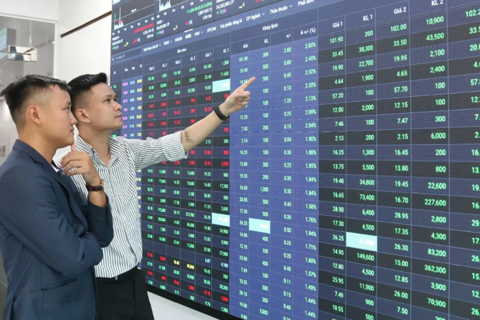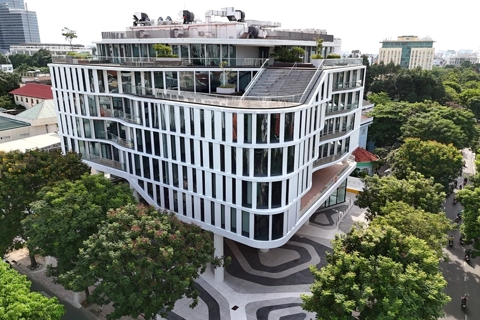Vietnamese Gov’t plans to revise up 2025 GDP growth target to over 8%
The revision of this year's GDP target will help lay the foundation for double-digit growth from 2026, propelling the country into a prosperous development phase.
The Vietnamese Government has proposed adjusting the GDP growth target for 2025 from 6.5-7% to over 8%, laying the foundation for double-digit growth from 2026 onwards and ushering the country into an era of prosperity.
| Electronics production at Katolec Vietnam in Quang Minh Industrial Cluster, Hanoi. Photo: Pham Hung/The Hanoi Times |
The move was discussed during a debate session of the National Assembly Standing Committee on February 10 on a proposal to supplement the 2025 socio-economic development plan.
Presenting the proposal on behalf of the Prime Minister, Minister of Planning and Investment Nguyen Chi Dung stated that the government is seeking to adjust the GDP growth target for 2025 to at least 8%, 1-1.5 percentage points higher than the target set by the National Assembly last year. The average consumer price index (CPI) is projected to be at around 4.5-5%. This would take the GDP in 2025 to around $500 billion, with per capita income reaching around $5,000. In this scenario, economic sectors would grow by 0.7-1.3% more than in 2024, with industry and construction—especially manufacturing and processing—remaining the key drivers of growth.
The Government estimates that total social investment will exceed $174 billion, equivalent to 33.5% of GDP. This includes public investment of around $36 billion, private investment of $96 billion, foreign direct investment (FDI) of $28 billion, and other investments totaling $14 billion.
Total retail sales of goods and consumer services (at current prices) are expected to grow by at least 12% this year.
To achieve this goal, the GDP growth rate in each locality should be at least 8-10%, particularly in major economic hubs such as Hanoi, Ho Chi Minh City, and other key growth areas, said Dung.
By the end of 2024, the fiscal deficit is expected to be around 3.4% of GDP. If necessary, the Government is proposing to adjust the state budget deficit to approximately 4-4.5% of GDP to mobilize resources for development investment. Public debt, government debt, and external debt may reach or exceed the alert threshold (around 5% of GDP), he noted.
To achieve the 8% growth target this year, the Government has outlined several measures, including improving institutional frameworks, accelerating public investment disbursement, and promoting private investment and industrial manufacturing.
Chairman of the National Assembly's Economic Committee Vu Hong Thanh stated that adjusting this year's GDP target will help lay the foundation for double-digit growth from 2026, propelling the country into a prosperous development phase.
However, he noted that business activity in early 2025 has yet to show strong signs of improvement, with the industrial production index (IIP) in January rising just 0.6% year-over-year and the purchasing managers' index (PMI) remaining below 50 points for two consecutive months.
“These indicators suggest that business conditions in Vietnam’s manufacturing sector are contracting,” Thanh said, adding that the Government needs to carefully assess the feasibility of achieving GDP growth above 8%, especially in terms of financial security and public debt sustainability.
Regarding the 4.5-5% CPI target, the Economic Committee agreed that this adjustment is necessary to create room for fiscal and monetary policy management to support economic growth. However, as inflation directly affects business costs, Thanh urged the Government to take appropriate control measures.
On the fiscal deficit and public debt, the committee acknowledged the need for adjustments to mobilize resources for development.
| Hanoi from above. Photo: Thanh Hai/The Hanoi Times |
"The Government needs to use resources effectively, ensuring public debt safety and repayment capacity, especially the ratio of public debt obligations compared to total budget revenues," Thanh cautioned.
National Assembly Secretary General Le Quang Tung suggested that, given the limited time to implement measures to achieve the 8% GDP target, proposed solutions must be immediate and have an immediate impact.
“The Government should introduce policies that can be implemented immediately, such as visa exemptions and aviation policies, to generate immediate economic benefits,” Tung recommended.
Beyond fostering growth in economic hubs, the government must also address the challenges faced by businesses to unlock capital flows and stimulate domestic consumption.
In the context of global economic volatility, trade tensions among major economies, and changing trends in trade and technology, the Economic Committee urged the Government to develop contingency plans to capitalize on these changes.
In particular, fiscal and monetary policies must continue to be managed proactively and flexibly, while expenditure should be closely aligned with budget projections, with savings prioritized for key national projects, social security, and budget balance, said Tung.
As the Government reorganizes its administrative structure, the committee stressed that this process must not disrupt public services or hinder business operations.
In response, the Minister of Planning and Investment stated that the Government has identified both short- and long-term strategies to achieve high economic growth. He reiterated that the government would incorporate feedback to ensure realistic and effective policy measures, with the overarching goal of maintaining proactive economic management and increasing development investment.
The National Assembly is expected to consider and approve the resolution adjusting the 2025 economic growth target to above 8% during an extraordinary session beginning on February 12.












